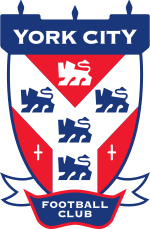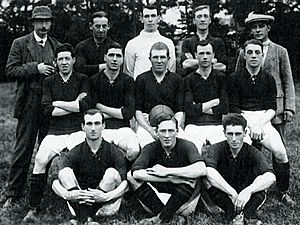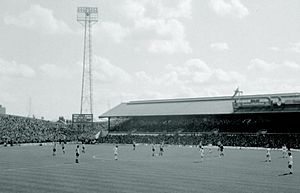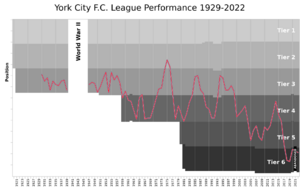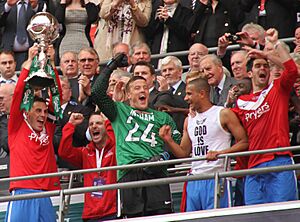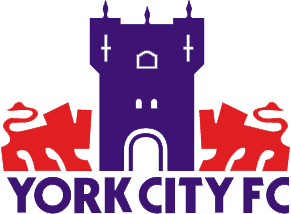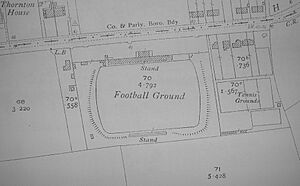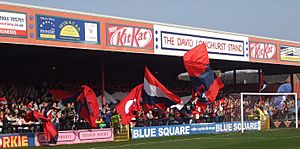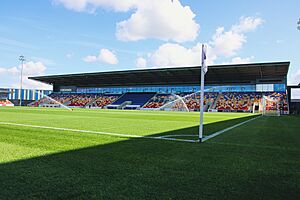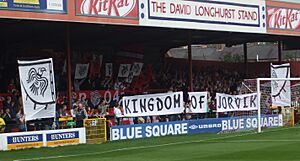York City F.C. facts for kids
York City Football Club is a professional association football team from York, England. They are known as "The Minstermen" and play in red kits. As of the 2024–25 season, they compete in the National League, which is the fifth level of English football.
The club was started in 1922 and played in non-League football for seven years. They then joined the Football League. York City had their best run in the FA Cup in 1954–55, reaching the semi-final. They moved between the Third and Fourth Divisions, and even spent two seasons in the Second Division in the 1970s. In 1993, York City played at Wembley Stadium for the first time and won a play-off final.
In 2004, they left the Football League but returned in 2012 after winning the 2012 FA Trophy final and a play-off final at Wembley. They were relegated back to non-League football in 2016. York City played at Fulfordgate and then Bootham Crescent for 88 years. In 2021, they moved to their current home, the York Community Stadium. Their main rivals are Hull City and Scarborough. Barry Jackson has played the most games for the club, and Norman Wilkinson is their top goalscorer.
Contents
Club History
Early Years and Joining the Football League (1922–1981)
York City Football Club was founded in May 1922 and joined the Midland League. They played there for seven seasons. In 1929, the club was voted into the Football League, joining the Third Division North. Their first Football League match was a 2–0 win against Wigan Borough.
In the 1937–38 FA Cup, York City had an exciting run. They beat top-tier teams like West Bromwich Albion and Middlesbrough. They reached the sixth round before being knocked out. After World War II, football started again in 1946. York City had a great FA Cup run in 1954–55, reaching the semi-final. They drew 1–1 with Newcastle United before losing the replay. This made them the first third-tier club to play in an FA Cup semi-final replay.
In 1959, York City was promoted for the first time to the Third Division. They were relegated after one season but earned promotion again in 1965 and 1971. In 1974, York City reached the Second Division for the first time, which was a big achievement. They finished 15th in their first season there. However, they were relegated back to the Third Division in 1976 and then to the Fourth Division in 1977.
Ups and Downs: Promotions and Leaving the League (1981–2004)
In the 1983–84 season, York City won the Fourth Division championship. They were the first Football League team to get over 100 points in a season, finishing with 101 points. In the 1984–85 FA Cup, York City famously beat Arsenal 1–0. They then drew with European Cup winners Liverpool before losing the replay.
In 1993, York City won the Third Division play-off final at Wembley Stadium. They beat Crewe Alexandra in a penalty shootout to get promoted to the Second Division. They also had impressive wins in the League Cup. In 1995–96, they beat Premier League champions Manchester United 4–3 on aggregate, including a 3–0 win at Old Trafford. The next season, they beat Everton in the League Cup.
In 1999, York City was relegated from the Second Division. The club faced financial problems in the early 2000s. In 2002, a new owner, John Batchelor, took over, but the club went into administration. The Supporters' Trust (ST) bought the club in 2003 to save it. However, in 2004, York City was relegated from the Third Division to the Football Conference, ending 75 years in the Football League.
Return to the League and Recent Years (2004–Present)
After leaving the Football League, York City reached the play-off semi-finals in 2007. They also reached the 2009 FA Trophy final at Wembley, but lost. In 2012, York City won their first national knockout competition, beating Newport County 2–0 in the 2012 FA Trophy final at Wembley. A week later, they won the 2012 Conference Premier play-off final against Luton Town at Wembley, which meant they returned to the Football League after eight years.
York City stayed in League Two for four seasons. In 2014, they reached the League Two play-offs but lost in the semi-final. In 2016, they were relegated back to the National League. The next season, 2016–17, they were relegated again to the National League North. However, they ended that season by winning the 2017 FA Trophy final at Wembley, beating Macclesfield Town 3–2.
In 2022, York City was promoted back to the National League through the play-offs, beating Boston United 2–0 in the final. The Supporters' Trust briefly owned 100% of the club before selling a majority share to businessman Glen Henderson.
Club Identity
Nicknames and Kit Colors
York City is nicknamed "the Minstermen" because of York Minster, a famous cathedral in the city. This name became official in 1972. Before that, they were called "the Robins" because of their red shirts. During their FA Cup run in 1954–55, they were also known as "the Happy Wanderers."
|
|
| The original kit colours worn in the 1922–23 season |
For most of their history, York City has worn red shirts. However, in their very first season (1922–23), their kit was maroon shirts, white shorts, and black socks. They also wore maroon and white striped shirts for a few years in the 1920s. In 1933, they changed to chocolate and cream stripes, which was a nod to York's chocolate industry. They went back to red shirts in 1937.
In 1974, when they were promoted to the Second Division, a bold white "Y" was added to their red shirts, making them famous as "Y-fronts." Red shirts returned in 1978, often with navy blue shorts. In 2004, they switched to plain red and white, but in 2008, a mostly navy kit was introduced. They also had a light blue third kit in 2007–08 and a purple kit for the 2009 FA Trophy final. Since 2010, red shirts have been the main color again, worn with various colored shorts.
Club Crests
When the club started, they used the city's coat of arms as their crest, but it only appeared on shirts in 1950–51. In 1959, a new crest was designed with York Minster, the White Rose of York, and a robin, but it was never used on the shirts. From 1969 to 1973, the letters "YCFC" were on the shirts. The "Y-fronts" shirts from 1974 to 1978 had a special badge combining "Y" and "C."
In 1978, a new crest was introduced showing Bootham Bar, two lions, and the club name. This was updated to a colored version in 1983. When John Batchelor took over in 2002, the crest changed to "York City Soccer Club" with a checkered flag. After he left, the club went back to "York City Football Club," and a new logo was chosen by supporters. This badge features five lions, mostly navy blue on a white Y-shape, with a red background and a white lion in the middle.
Tables of kit suppliers and shirt sponsors appear below:
| Kit suppliers | ||
|---|---|---|
| Dates | Supplier | |
| 1975–1976 | Umbro | |
| 1976–1982 | Admiral | |
| 1982–1983 | Le Coq Sportif | |
| 1983–1987 | Hobott | |
| 1987–1988 | Rodsport | |
| 1989–1991 | ABC Sport | |
| 1991–1995 | Cavendish Sports | |
| 1995–2001 | Admiral | |
| 2001–2003 | Own brand | |
| 2003–2017 | Nike | |
| 2017–2018 | Avec | |
| 2018–2021 | Under Armour | |
| 2021–2024 | Puma | |
| 2024–present | Hummel | |
| Shirt sponsors | |
|---|---|
| Dates | Sponsor |
| 1981–1983 | Newitt's |
| 1984 | Hansa |
| 1984 | Cameron's |
| 1985–1990 | Hansa |
| 1990–1991 | Flamingo Land |
| 1991–2001 | Portakabin |
| 2001–2003 | York Evening Press |
| 2003–2005 | Phoenix Software |
| 2005–2009 | CLP Industries |
| 2009–2012 | Pryers Solicitors |
| 2012–2019 | Benenden Health |
| 2019–2023 | JM Packaging |
| 2023–present | Titan Wealth Holdings |
Club Grounds
Fulfordgate: The First Home
York City's first football ground was Fulfordgate, located in Fulford, York. They played their first match there on 20 September 1922. The ground was slowly improved over time, adding covered stands and seating. By 1929, it could hold about 17,000 fans. However, because it was far from the city center, attendance started to drop. In 1932, the club decided to move to a new ground closer to the city.
Bootham Crescent: The Long-Time Home
Bootham Crescent became York City's new home in 1932. It was officially opened on 31 August 1932 with a match against Stockport County. The record attendance at Bootham Crescent was 28,123 people for an FA Cup match in 1938. The ground was damaged slightly during World War II.
Over the years, many improvements were made to Bootham Crescent. The club bought the ground in 1948. Floodlights were installed in 1959 and updated in 1980. In 1991, the David Longhurst Stand was built, named after a York player who sadly passed away. New, more powerful floodlights were put in place in 1995.
In 1999, York City no longer owned Bootham Crescent directly. The club faced financial difficulties, but the Supporters' Trust bought the ground back in 2004 with a loan. For a few years, it was called KitKat Crescent due to a sponsorship deal, but most people still called it Bootham Crescent. The ground needed major repairs, and the club had to find a new home.
York Community Stadium: The Modern Home
Because of the loan terms and the condition of Bootham Crescent, York City needed a new stadium. In 2008, the City of York Council announced plans for a new community stadium for both York City and the city's rugby league team. The chosen site was at Monks Cross.
Construction on the new stadium began in 2017. After some delays, it was finished in December 2020. York City officially moved into the stadium in January 2021. The first match there was played without fans because of the COVID-19 pandemic. The York Community Stadium has 8,500 seats.
Supporters and Rivalries
York City has many fan groups, including the East Riding Minstermen and the Supporters' Trust. The club publishes an official match programme called The Citizen. Fans have also created their own magazines, known as fanzines, over the years. The club's mascot is a lion named Yorkie the Lion, who entertains fans before matches.
York City's main rivals have traditionally been Hull City and Scarborough. While York fans often see Hull City as their biggest rival, Hull City fans usually consider Leeds United their main rival. York City also had rivalries with Halifax Town and Luton Town, especially during their time in the Conference league.
Club Records and Statistics
The player with the most appearances for York City is Barry Jackson, who played 539 matches. He also holds the record for most league appearances with 428 games. Norman Wilkinson is the club's top goalscorer, with 143 goals in all competitions. Six other players have scored over 100 goals for the club.
The first York City player to play for his country was Eamon Dunphy, who played for the Republic of Ireland in 1965. The player with the most international appearances while at York City is Peter Scott, who played seven times for Northern Ireland.
York City's biggest win was 9–1 against Southport in 1957. Their heaviest loss was 12–0 to Chester City in 1936. In the FA Cup, their biggest win is by six goals, achieved five times. Their record FA Cup defeat was 7–0 to Liverpool in 1985.
The highest attendance at their old Fulfordgate ground was 12,721. At Bootham Crescent, the highest attendance was 28,123 for an FA Cup match in 1938.
The highest fee York City has received for a player is £950,000 for Richard Cresswell in 1999. The most expensive player they bought was Adrian Randall for £140,000 in 1995. The youngest player to play for the club was Reg Stockill, who was 15 years and 281 days old in 1929. The oldest player was Paul Musselwhite, who played his last match at 43 years and 127 days old in 2012.
Players
First-team squad
Note: Flags indicate national team as defined under FIFA eligibility rules. Players may hold more than one non-FIFA nationality. Squad correct as of 15 July 2025.
| No. | Pos. | Player | Nation |
|---|---|---|---|
| 1 | GK | Harrison Male | |
| 2 | DF | Ryan Fallowfield | |
| 4 | DF | Darragh O'Connor | |
| 5 | DF | Callum Howe (captain) | |
| 6 | MF | Paddy McLaughlin | |
| 7 | FW | Tyrese Sinclair | |
| 8 | MF | Alex Hunt | |
| 10 | FW | Ollie Pearce | |
| 11 | FW | Ashley Nathaniel-George | |
| 12 | FW | Leone Gravata | |
| 13 | GK | George Sykes-Kenworthy | |
| 15 | MF | Marvin Armstrong | |
| 16 | GK | Rory Watson | |
| 18 | MF | Dan Batty | |
| 20 | MF | Ricky Aguiar | |
| 23 | DF | Joe Felix | |
| 24 | FW | Josh Stones | |
| 25 | FW | Mo Fadera | |
| 28 | DF | Malachi Fagan-Walcott | |
| 32 | DF | George Grumley | |
| — | MF | Ollie Banks | |
| — | MF | Hiram Boateng | |
| — | DF | Ben Brookes | |
| — | DF | Tyler Cordner | |
| — | FW | Joe Grey | |
| — | DF | Mark Kitching | |
| — | MF | Alex Newby | |
| — | MF | Greg Olley | |
| — | DF | Ash Palmer |
| No. | Pos. | Player | Nation |
|---|---|---|---|
| 19 | FW | Billy Chadwick (at Scunthorpe United until January 2026) | |
| 21 | DF | Cameron John (at Hartlepool United for 2025–26 season) | |
| 31 | DF | Jeff King (at Boreham Wood until January 2026) |
Club Officials
Ownership
- 394 Sports (51%)
- York City Supporters' Society (25%)
- FB Sports (24%)
Board
- Co-chairs: Julie-Anne Uggla • Matthew Uggla
- Directors: James Daniels • Billy Ford • Tim Ford • Alastair Smith • Simon Young
Management and backroom staff
- Manager: Adam Hinshelwood
- Assistant manager: Gary Elphick
- First-team coach: Cameron Morrison
- Goalkeeping coach: Joe Stead
- Kit & equipment manager: Lewis Saleem
- Head of science and medicine: Sam Mannings
Honours and Achievements
York City has won several titles and achieved promotions throughout its history:
League Achievements
- Third Division (level 3)
- Promoted: 1973–74
- Fourth Division / Third Division (level 4)
- Champions: 1983–84 (first Football League team to reach 100+ points)
- Promoted: 1958–59, 1964–65, 1970–71
- Play-off winners: 1993
- Conference Premier (level 5)
- Play-off winners: 2012
- National League North (level 6)
- Play-off winners: 2022
Cup Achievements
- FA Trophy
- Winners: 2011–12, 2016–17
- Runners-up: 2008–09
See also
 In Spanish: York City Football Club para niños
In Spanish: York City Football Club para niños


